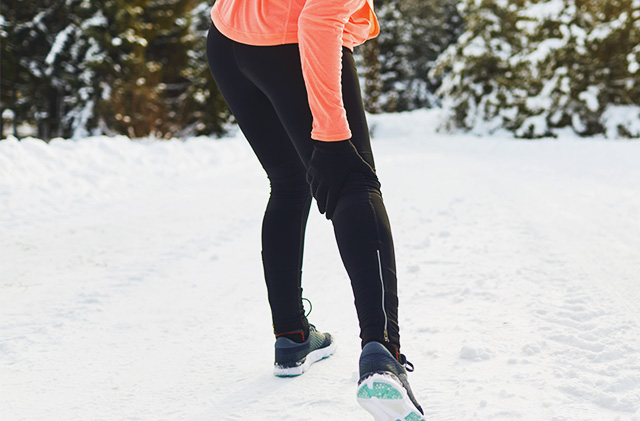Arthritis Pain Relief Tips for Winter

For those who have arthritis, winter is anything but a wonderland. Arthritis pain relief is a lot harder to manage during the colder months. As the outside temperature plummets, it causes a sudden drop in barometric pressure, which causes joints to swell. These conditions make the pain associated with many arthritic conditions more apparent.
Below are some helpful tips you can use to lessen the pain you feel in the winter.
Staying Warm is Key for Joint Pain Relief
Clearly, the best way to avoid the cold is to stay indoors in an area with adequate temperature control. However, if you need to go outdoors, one of the best ways to combat cold weather aches and pains is to layer yourself in warm clothing made from quick-drying materials like wool.
If you suffer from hip or knee arthritis, you may also want to wear long underwear to provide an extra layer of warmth to your lower extremities.
Keep your hands and feet warm too! Wearing a good pair of insulated gloves and extra thick socks can help.
If you come home and are still experiencing joint pain from the cold, you can also spend some time in a warm bath.
Stay Active. Preferably Indoors.
Exercise is one of the best activities for proactive arthritis pain relief. It’s also a great way to improve your overall health. Routine exercise helps to improve your flexibility, energy levels, and muscle strength, all of which can help reduce joint pain.
Low impact exercises will put the least stress on your joints. Some great options are:
- Yoga
- Indoor cycling or elliptical machines
- Aerobics
- Weight training
- Walk or run on treadmills or cushioned indoor tracks
The CDC recommends you start low and slow if you're new to exercising. Begin with a small amount of activity, 2-10 minutes twice a day. Get plenty of rest between exercises. As you get more acclimated to your new activities, you can increase the duration and intensity of your workouts.
Wear Compression Gear
Compression gear like gloves, socks, and arm sleeves have provided pain relief for joints for years. These items help increase circulation, which is shown to lessen the pain associated with arthritis. Compression gear is especially useful during the chilly winter months because it can trap heat, doubling as an extra layer to keep your hands and legs warm.
There are a few factors to consider when shopping for compression gear:
- Find the best fit that feels comfortable but still provides a noticeable level of pressure. You want a fabric that also provides the most mobility. Many specialty medical supply stores train their employees to find the best fit that won’t hinder your motion or cut off circulation.
- Many compression gloves are fingerless, making it easier to use touchscreen phones. If you plan to spend a considerable amount of time in the cold, you may want to opt for full-finger gloves.
- Look for fabric that provides a bit of breathability to reduce sweating.
Vitamin D and Omega- 3 Can Help with Arthritis Pain Relief
Vitamin D helps the body absorb calcium more efficiently, which promotes stronger bones. As a result, lack of vitamin D can lead to increased sensitivity to arthritic pain. Usually, our bodies get a good amount of vitamin D through our diets. Our bodies can also synthesize vitamin D through the ultraviolet light we absorb from sunlight. However, the cold weather can bring heavier cloud cover and the desire to stay indoors, so it’s important to monitor your vitamin D intake during this time to ensure you’re getting enough.
The National Institutes of Health (NIH) suggests adults should take in 20 and 50 ng/mL of vitamin D a day.
Eat foods that are high in omega-3 fatty acids, such as salmon or mackerel, which are rich in vitamin D. There are also plenty of products on the market (like milk and cereals) that are fortified with omega-3 and vitamin D.
You can also take vitamin D supplements and fish oil to increase your intake. In fact, just one teaspoon of cod liver oil can contain 100% of your daily vitamin D requirements.
Maintain a Healthy Weight
The more stress you put on your joints, the more pain you’ll likely feel. Maintaining a healthy weight will provide pain relief for your joints by reducing the stress on them.
Studies show that adults with high body mass indexes (BMIs) had an increased occurrence of brown adipose tissue that releases pro-inflammatory chemicals that can affect joints. Inflammation can also trigger a negative autoimmune response, which can lead to conditions like rheumatoid and psoriatic arthritis. Obesity has also been linked to increased instances of knee arthritis.
Eating a healthy diet and living an active lifestyle (two other tips we’ve listed) are the best ways to keep you at a healthy weight.
NY Orthopedics has multiple clinics across New York and an office in New Jersey with physicians who specialize in arthritis pain relief. To learn more about relieving arthritis pain, schedule an appointment today!
